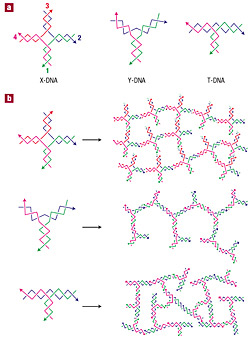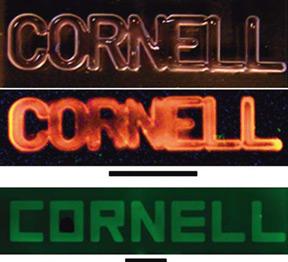Using synthetic DNA, Cornell researchers fashion low-cost, biodegradable hydrogels for drug delivery and tissue engineering
By Bill Steele

Using synthetic DNA formed into crosses, Y's and T's, Cornell researchers have created biocompatible, biodegradable, inexpensive hydrogels that can be easily formed into any desired shape for biomedical applications.
Hydrogels are liquid or semisolid materials composed of long-chain molecules cross-linked to one another to create many small empty spaces that can absorb water or other liquids like a sponge. If the spaces are filled with a drug, the hydrogel can dispense the drug gradually as the structure biodegrades. Widespread research also is under way on using hydrogels as scaffolds for tissue engineering and tissue repair, where the spaces in the gel might be filled with stem cells, tissue-growth factors or a combination of both.
Hydrogels for these purposes are usually made from organic or inorganic polymers (molecules that form long chains), such as alginate from seaweed. Some have been made from proteins but none entirely from ordinary DNA. So far, all these processes have used organic solvents or acids or involve high temperatures, making conditions too harsh for a drug or living cells, so the materials to be encapsulated must be loaded in afterward.
The new process, developed in the laboratory of Dan Luo, Cornell assistant professor of biological and environmental engineering, uses no high temperatures or harsh chemicals, so the material to be encapsulated in the gel can be introduced before the gel is formed. Because the gel is made of only synthetic DNA, no immune response should be triggered, the researchers said, so the material encapsulated can include proteins and even live mammalian cells.
The research was published Sept. 24 in the online version of Nature Materials and will appear in a forthcoming print issue of the journal.
A DNA molecule is a long chain in a sequence that is unique to each chain. Conveniently, two chains with complementary sequences can lock onto one another like two halves of a zipper. By making synthetic DNA chains whose sequences are complementary over only part of their length, Luo and colleagues have created tree-shaped structures.

To create hydrogels, they made branched DNA that formed itself into crosses, Y's and T's with "sticky" ends that could link to each other with the help of enzymes known as ligases. The cross-shaped branched DNA forms a gel by linking together into sheets of tiny squares that tangle in three dimensions; Y shapes form hexagonal structures like a chain link fence that combine into a fibrous three-dimensional form, while T shapes create random, disorganized patterns that look like an assembly of scales.
The researchers found that they could easily alter certain properties of the resulting gelatinous materials, including rigidity and absorbency, by adjusting the types of branched DNA used and the concentration of DNA in the mix. To demonstrate the ability of some of the materials to hold their shape, the researchers created them in a variety of different molds, including some that spelled out "CORNELL" at centimeter and nanoscales.
To test the use of the DNA hydrogels for delivering drugs, the researchers encapsulated porcine insulin and the anticancer drug Camptothecin and observed that the drugs were released in a controlled manner over time. When they encapsulated live cells in a gel, they found that the cells were still alive three days later. It is possible, the researchers said, that live cells encapsulated in a DNA hydrogel could be recovered, still alive, by breaking down the DNA structure with enzymes.
Co-authors with Luo are Cornell graduate students Soong Ho Um, Jong Bum Lee and Sang Yeon Kwon, postdoctoral researcher Nokyoung Park, and Christopher Umbach, Cornell assistant professor of materials science and engineering. The research was partially supported by the Cornell Center for Materials Research, Cornell Center for Advanced Technology and a National Science Foundation Early Career Development Award.
Media Contact
Get Cornell news delivered right to your inbox.
Subscribe